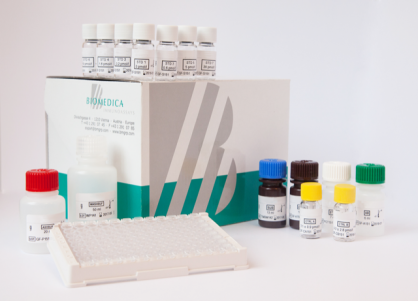Vanin-1 Mouse/Rat ELISA Assay
The Vanin-1 Mouse/Rat ELISA Assay is For Research Use Only
Product Developed and Manufactured in Austria by Biomedica
Size: 12×8
Sensitivity: 2.31 pmol/l
Standard Range: 2.31 – 200 pmol/l
Incubation Time: 4.5 hours
Sample Type: Serum, plasma and urine
Sample Size: 5 µl / well
Controls Included
Conversion factor: 1 ng/ml = 19.2 pmol/l (MW: 52.07 kDa)
Assay Principle
The Vanin-1 mouse/rat ELISA Assay is a sandwich enzyme immunoassay for the quantitative determination of mouse/rat Vanin-1 in serum, plasma or urine samples. In a first step, assay buffer is pipetted into the wells of the microtiter strips. Thereafter, standard/control/sample and detection antibody (polyclonal sheep anti-mouse Vanin-1-HRPO) are pipetted into the wells, which are pre-coated with anti-mouse Vanin-1 antibody. Vanin-1 present in the standard/control/sample binds to the pre-coated antibody in the well and forms a sandwich with the detection antibody. In the washing step, all non-specific unbound material is removed. In a next step, the substrate (TMB, tetramethylbenzidine) is pipetted into the wells. The enzymecatalyzed color change of the substrate is directly proportional to the amount of Vanin-1 present in the sample. This color change is detectable with a standard microplate reader. A dose response curve of the absorbance (optical density, OD at 450 nm) versus standard concentration is generated using the values obtained from the standards. The concentration of Vanin-1 in the sample is determined directly from the dose response curve The kit utilizes recombinant mouse Vanin-1 as a calibrator. The VNN1 gene is conserved in chimpanzee, rhesus monkey, dog, cow, mouse, rat, and chicken.
Related Products
Urine Vanin-1 ELISA Assay
Anti-Beta2 Glycoprotein 1 IgG ELISA


